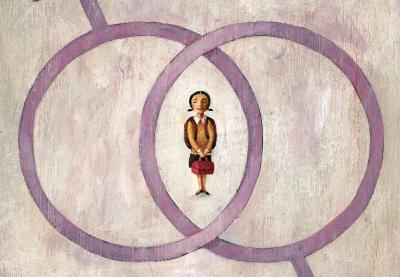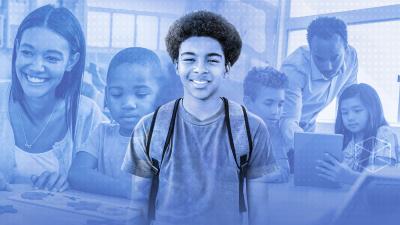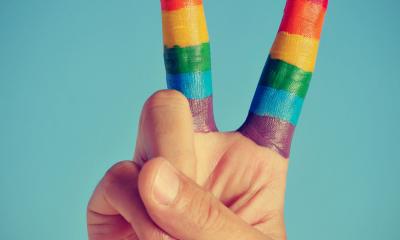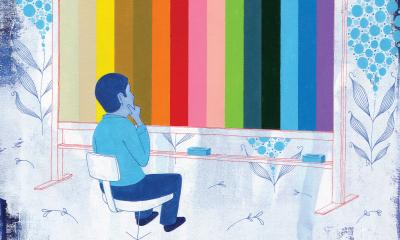Before Michele Hatchell and her partner, Liz, sent their child, Mimi, to school for the first time, the family sat down and created a script. “What can you say,” Hatchell prompted, “if someone asks if you have two moms?” They helped Mimi come up with answers: Yes, I have two moms. Who’s in your family? And, Yes, there are a lot of families like mine. They sent Mimi’s teacher picture books depicting families with two mothers. And they met with the principal, requesting Mimi be placed in the same classroom as another child with same-sex parents.
“It’s hard being the only one of anything,” Hatchell says. “We didn’t want Mimi feeling singled out for being different.”
Hatchell, who teaches art at Shorewood Hills Elementary School in Madison, Wis., was one of the first openly gay teachers on staff. She understands the concerns of LGBT parents sending their children to school for the first time: Will this be a safe place for my child? Will our family be welcome here?
It’s About Family
“People get uncomfortable talking about gay and lesbian issues at the elementary level because they think it’s about sex,” Hatchell says. “But really it’s about family.”
In fact, the “family unit” is one of the first lessons young children encounter in school.
In a 2012 study titled Playgrounds and Prejudice, researchers from the Gay, Lesbian and Straight Education Network asked a national sample of elementary-grade teachers if they included LGBT examples when teaching about family. Eight of 10 said no. When asked why, the most common response was, “It hasn’t come up.”
This is alarming news for the 7 million LGBT parents who have children in U.S. schools—and it suggests a silence that arguably violates the code of ethical conduct from the National Association for the Education of Young Children, which prohibits “practices that are emotionally damaging” and “disrespectful.”
“There is a huge connection between family representation and self-esteem,” veteran K-3 teacher Erica Eide explains. “If a child doesn’t see their family represented, it creates a disconnect and interrupts their learning. If you don’t feel recognized by your peers and your surroundings, how can you thrive?”
Involved but Invisible
In 2008, GLSEN worked with COLAGE (a national movement of children, youth, and adults with one or more LGBTQ parents) and the Family Equality Council to release the first national study examining the experiences of lesbian, gay and transgender parents of children in K-12 schools.
The report, Involved, Invisible, Ignored, found that while LGBT parents are more likely to participate in their children’s education, they often feel unwelcomed by their children’s schools.
Parents told researchers of elaborate prep work—meeting teachers in advance, providing classroom sets of LGBT-inclusive books, sharing advice and experiences with other LGBT parents. Some spoke of moving to neighborhoods with more accepting schools, while others described classroom practices that were frustrating to navigate—from school forms requesting the names of “mother” and “father” to rules forbidding non-biological parents from picking up their children at school.
When Tom Murphy and his husband, Dino, sent their daughter Michelle to school for the first time, there weren’t many books in the school library about kids with two dads. Letters would arrive home addressed to “Mr. and Mrs. Murphy,” and Michelle was regularly told to take things home to her “mom and dad.”
“At the very least, it’s a lack of acknowledgement of your existence,” says Murphy, an administrator at a foster care agency in Hamden, Conn. “It’s hurtful to not be acknowledged. Kids may start to think, ‘I guess my family isn’t as good as other families, because I never hear about families that look like us.’”
Learning the Language
In 2002, employees of the California-based Parent Services Project, a national nonprofit that works with early childhood educators to improve parental involvement, decided to offer professional development training to help educators improve their support for LGBT families. They quickly discovered such a program didn’t exist—so they worked with City College of San Francisco to create one. Today, the curriculum, called Making Room in the Circle, is offered as a regular course at universities across the country.
“For many early childhood educators, there is fear around addressing LGBT issues in their classrooms,” says PSP Executive Director Jenny Ocón. “We know it takes a lot of courage to speak up.”
Participants are often surprised to learn how their classroom conduct can reinforce unwelcoming environments. For example, activities as commonplace as creating Mother’s Day cards can create awkward moments for children with two dads.
Not every educator who takes the training necessarily approves of same-sex marriage or is comfortable with LGBT issues. But Ocón says that isn’t the point.
“Even if you believe that to be true, it’s important to think about the well-being of the child in that family,” she says. “Not acknowledging that family would do real harm to that child—that’s the place we keep coming back to.”
Hitting the Books
Twenty years ago, children’s books that openly referenced LGBT families were almost nonexistent. But since Heather Has Two Mommies was published in 1989, the number of LGBT family-themed books for young readers has exploded.
Back in Wisconsin, Hatchell regularly recommended these titles to her colleagues, but she worried there were few such books in the school library. “Our teachers wanted to create inclusive curriculum,” Hatchell says, “but we didn’t have the resources to make it happen.”
So last year, she successfully applied for a district grant to provide LGBT family-friendly books—along with sample lesson plans and staff training—to every school in the city. “It’s not my child’s job to teach other kids about families with two moms,” Hatchell says. “It’s the school’s responsibility, even when there aren’t any children with LGBT families in the class.”
The books have been an immediate hit with parents, teachers and children.
One afternoon earlier this year, Shorewood Hills third-grader Suzanne Oriel browsed the books on display in Hatchell’s art room. “They help other kids be more accepting,” Suzanne says. “It helps them think of our families as just regular families, too.”
Reading List for Mimi's Moms
These books include families that come in many shapes, sizes and structures:
ABC: A Family Alphabet Book
by Bobbie Combs
All Families Are Special
by Norma Simon
And Tango Makes Three
by Justin Richardson and Peter Parnell
Antonio’s Card/La Tarjeta de Antonio
by Rigoberto Gonzalez
Carly: She’s Still My Daddy
by Mary Boenke
Daddy, Papa, and Me
by Lesléa Newman
Emma and Meesha My Boy:
A Two Mom Story
by Kaitlyn Taylor Considine
Everywhere Babies
by Susan Meyers
Families Like Mine: Children of Gay Parents Tell It Like It Is
by Abigail Garner
Heather Has Two Mommies:
20th Anniversary Edition
by Lesléa Newman
In Our Mothers’ House
by Patricia Polacco
King and King
by Linda de Haan and Stern Nijland
King and King and Family
by Linda de Haan and Stern Nijland
Sources: Parent Services Project, Madison Metropolitan School District, Cooperative Children’s Book Center





0 COMMENTS